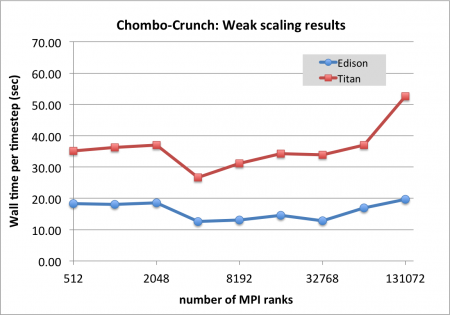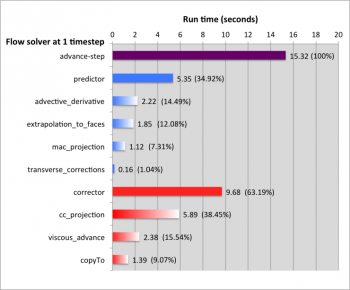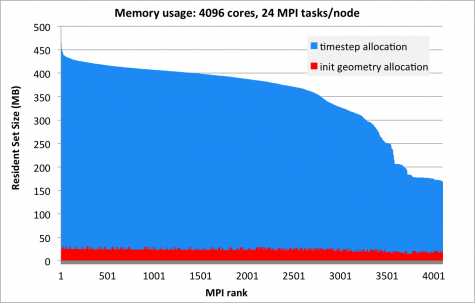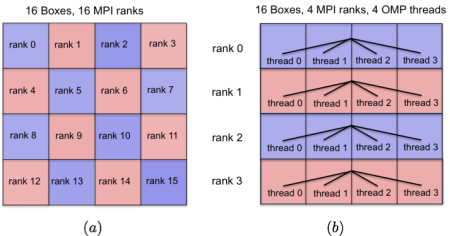Chombo-Crunch¶
Background¶
Chombo-Crunch is a high-performance software package which has been developed jointly by research scientists from Applied Numerical Algorithms Group, Computational Research Division (PI: David Trebotich) and Earth Sciences Division at LBNL for large-scale numerical simulations of complex fluid flows with particular interest in modeling of subsurface flows. One important application example of subsurface flow is a carbon sequestration - the process of capturing carbon dioxide before it enters the atmosphere and transferring it into the earth. It is a promising technique to help control greenhouse gas emissions and attenuate climate change. From numerical point of view, modeling of carbon sequestration process is a challenge due to need to solve equations in very complex fractal geometry and to incorporate all important physical mechanisms occurring at vast range of scales - from order of 100 kilometers at reservoir scale to submicron at pore scale. To address these challenges, Chombo-Crunch has been developed by merging high performance CFD capabilities of Chombo package with the geochemistry package CrunchFlow to model reactive transport processes in resolved pore space.
Starting point¶
We start with a flat MPI version of Chombo-Crunch code (baseline). It has been previously optimized for current architectures. Results of weak scaling analysis on Cray XC30 at NERSC (Edison) and Cray XK7 at ORNL (Titan) are shown in a figure below.

The next two figures show the results of profiling analysis for baseline version of Chombo-Crunch. The figure on the left depicts partitions of walltime spent by different flow solver parts: velocity predictor, velocity corrector, etc. (in the framework of finite-volume projection method for incompressible Navier-Stokes equations). For instance, one can see that the velocity corrector takes approximately 63% of the total cost and its main contribution is due to cell-centered projection operator. The figure on the right shows profiling results from CrayPat. It clearly seen that there is a significant MPI overhead due to almost 20% spent in MPI_Waitall. It gives us some hints for optimization of load balance problem: in this test case the geometry is a porous media and some boxes (part of computational domain after decomposition) have only covered cells with no computational loads. Processes assigned with covered boxes are waiting all other process which have to complete the computation of flow fluxes before exchanging data with neighbor-boxes.


Optimization strategy¶
First step is optimization of memory usage. For current architectures at optimal settings (optimal number of mesh points per box) Chombo-Crunch uses about 450MB per core. Ideally to have more flexibility in the context of hybrid memory (High Bandwidth Memory and flat DDR4) on Cori it is required to reduce this amount to at least 100 MB/core. Figure below shows the memory allocation (resident set size) versus MPI rank for test case with realistic flow configuration in complex porous media geometry.

Second step is an implementation of thread safe OpenMP by introducing threads into Chombo's data iterators. Instead of using a data iterator over all boxes assigned to given MPI rank we use a loop over boxes assigned to current MPI rank and use data iterators for each box. The loop over boxes can be threaded with OpenMP assuming 1 thread per box.
The schematic below illustrates the idea of code modification from flat MPI to hybrid MPI+OpenMP: the left figure shows a flat MPI case with 16 MPI ranks and 1 box per rank; the right figure shows MPI+OpenMP implementation with 4 MPI ranks and 4 OpenMP threads per MPI rank.

References¶
-
David Trebotich, Daniel T. Graves, "An Adaptive Finite Volume Method for the Incompressible Navier-Stokes Equations in Complex Geometries", Communications in Applied Mathematics and Computational Science, 2015
-
C. Steefel, S. Molins, D. Trebotich, "Pore scale processes associated with subsurface CO2 injection and sequestration”, Reviews in Mineralogy and Geochemistry", Reviews in Mineralogy and Geochemistry, 2013
-
M. Adams, P. Colella, D. T. Graves, J.N. Johnson, N.D. Keen, T. J. Ligocki. D. F. Martin. P.W. McCorquodale, D. Modiano. P.O. Schwartz, T.D. Sternberg and B. Van Straalen, Chombo Software Package for AMR Applications - Design Document, Lawrence Berkeley National Laboratory Technical Report LBNL-6616E